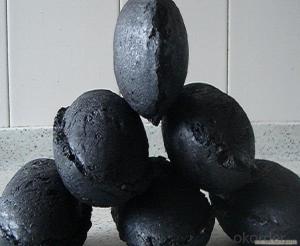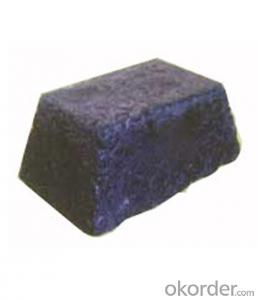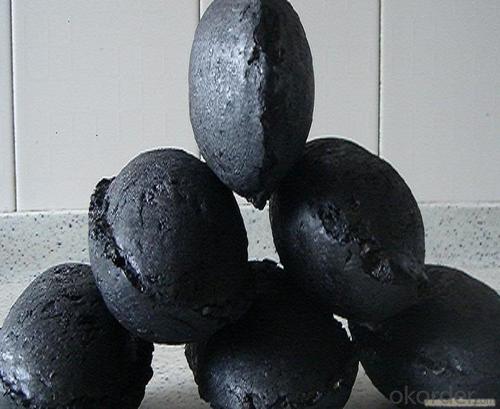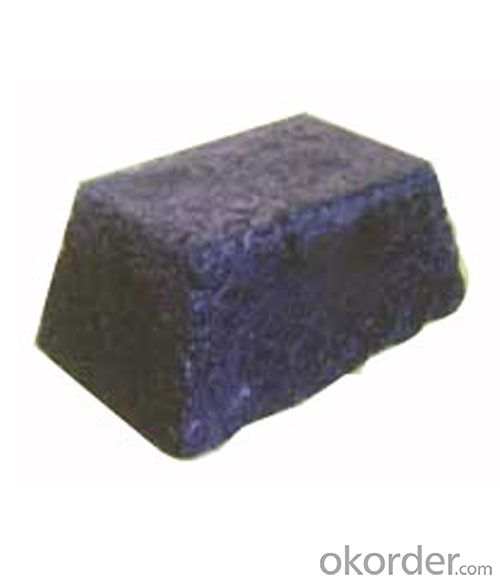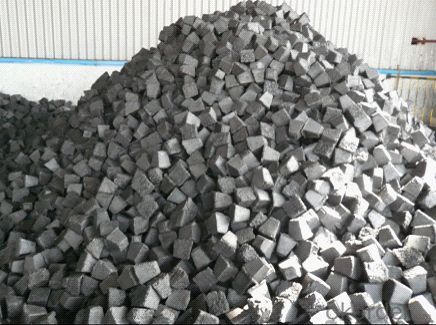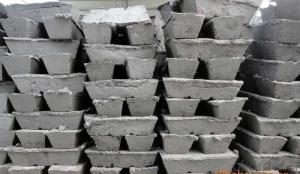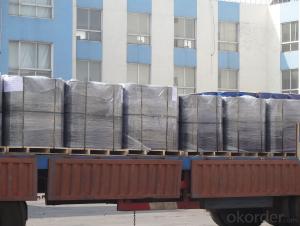China-Made Low Ash Carbon Electrode Paste -Ash7
- Loading Port:
- China main port
- Payment Terms:
- TT OR LC
- Min Order Qty:
- 0 m.t.
- Supply Capability:
- 20000 m.t./month
OKorder Service Pledge
OKorder Financial Service
You Might Also Like
Packaging & Delivery
| Packaging Details: | 1 mt bag or bulk package |
| Delivery Detail: | 15-30 days after we get the deposit or original L/C |
Specifications
1)Low ash content
2)Good thermal conductivity
3)High resistance to temperature
4)Stable quality
Main Function And Features
1) Low ash content
2) Good electric and thermal conductivity
3) High resistance to temperature
4) Stable quality
5) Reasonable price
6) Size:all kinds of electrode paste
7) Accord customer's reques change
Introduction To Products
1) Carbon Electrode Paste is a self-baking electrode used in submerged arc furnaces for delivering power to the charge mix.
2) Electrode Paste is added to the top of the electrode column in either cylindrical or briquette form.
3) As the paste moves down the electrode column the temperature increase causes the paste to melt and subsequently bake
forming a block of electrically conductive carbon.
4) Electrode Paste is essentially a mix of Electrically Calcined Anthracite (ECA) or Calcined Petroleum Coke (CPC) with Coal
Tar Pitch.
Application Range
1) Be used as the electrode for self roasting in the iron-alloy furnace and acetylene furnace.
2) Amorphous graphite powder--applied in steel making,fireproof material,casting coating.
3) Calcined petroleum coke--used in foundry,metallurgy,carbon paste,graphite electrode.
4) Carbon anode scrap--used as smelting fuel for copper smelting industry.
5) Carbon electrode paste--applied in iron alloy,calcium carbide,ferroalloy,ferromanganese.
Graphite/Carbon Electrode Paste
Specification/Item | |||||||
Ash | max | 4.0%max | 5.0%max | 6.0%max | 7.0% Max | 9.0% Max | 11.0% Max |
VM | % | 12.0%-15.5% | 12.0%-15.5% | 12.0%-15.5% | 9.5.0%-13.5% | 11.5%-15.5% | 11.5%-15.5% |
Compress Strength | Mpa Max | 18.0Mpa Min | 17.0Mpa Min | 15.7Mpa Min | 19.6Mpa Min | 19.6Mpa Min | 19.6Mpa Min |
Specific Resistance |
μΩm Max | 65μΩm Max | 68μΩm Max | 75μΩm Max | 80μΩm Max | 90μΩm Max | 90μΩm Max |
Bulk Density | G/CM3 Min | 1.38G/CM3 Min | 1.38G/CM3 Min | 1.38G/CM3 Min | 1.38G/CM3 Min | 1.38G/CM3 Min | 1.38G/CM3 Min |
- Q: How does carbon dating work?
- The age of organic materials, such as plants, animals, and human remains, can be determined through the scientific technique known as carbon dating. This method relies on the continuous formation of carbon-14, a radioactive isotope of carbon, in the atmosphere due to cosmic rays. Carbon-14 is absorbed by living organisms through photosynthesis or consumption. The ratio of carbon-14 to stable carbon isotopes (carbon-12 and carbon-13) in the atmosphere remains relatively constant as living organisms maintain equilibrium by exchanging carbon-14 with the atmosphere through respiration or consumption. However, when an organism dies, it no longer takes in carbon-14, leading to the decay of existing carbon-14 at a predictable rate. Carbon-14 has a half-life of approximately 5,730 years, meaning that after this period, half of the carbon-14 in a sample will have transformed into nitrogen-14. By measuring the remaining carbon-14 in a sample, scientists can calculate the time that has passed since the organism's death. The carbon dating process involves several steps. Initially, a sample is collected from the organic material to be dated, which can include wood, bones, or textiles. The sample is then prepared for analysis by eliminating any impurities and converting it into a suitable form for measurement. Subsequently, the sample is exposed to a high-energy radiation source, such as a particle accelerator or a nuclear reactor. This exposure causes the carbon atoms in the sample to emit beta particles, which are small bursts of energy. These particles are detected and measured using sensitive instruments, enabling scientists to determine the remaining amount of carbon-14 in the sample. Finally, this information is utilized to calculate the age of the organic material. By comparing the ratio of carbon-14 to carbon-12 in the sample to the known ratio in the atmosphere, scientists can estimate the elapsed time since the organism's death. Carbon dating is an invaluable tool for archaeologists, paleontologists, and geologists. It allows for the accurate determination of the ages of ancient artifacts, fossils, and geological formations. This technique has revolutionized our understanding of human history and the natural world, providing us with invaluable insights into the past.
- Q: Why is the solubility of carbon in austenite larger than that in ferrite?
- Ferrite: interstitial solution of carbon formed in alpha Fe.Austenite: interstitial solid solution formed by carbon in gamma Fe.The ferrite structure is a BCC lattice with a gap radius (0.291~0.154). Because of the smaller size of the lattice gap, the solubility of carbon in alpha -Fe is relatively small.
- Q: How does carbon impact the growth and development of plants?
- Carbon is essential for the growth and development of plants as it is a key component of photosynthesis. Through this process, plants convert carbon dioxide into glucose, their main source of energy. Carbon also plays a crucial role in forming the structural molecules of plants, such as cellulose, lignin, and proteins. Overall, carbon is vital for the overall health, productivity, and survival of plants.
- Q: How is carbon used in the production of fuel cells?
- Carbon is used in the production of fuel cells in several ways. One of the main uses of carbon in fuel cells is in the construction of the electrodes. Fuel cells consist of an anode and a cathode, and carbon-based materials such as graphite or carbon paper are commonly used to make these electrodes. These carbon-based materials provide a conductive surface for the electrochemical reactions that occur within the fuel cell. Additionally, carbon is used as a catalyst in fuel cells. Catalysts are substances that speed up chemical reactions without being consumed in the process. In fuel cells, carbon-based catalysts such as platinum or palladium are commonly used to facilitate the reactions that produce electricity. These catalysts allow for more efficient conversion of fuel into electrical energy. Furthermore, carbon is used in the form of carbon nanotubes in the production of fuel cells. Carbon nanotubes possess unique properties such as high surface area and excellent electrical conductivity, which make them ideal for enhancing the performance of fuel cells. They can be used to improve the efficiency of fuel cell reactions by providing a larger surface area for the reactions to take place on. Overall, carbon plays a crucial role in the production of fuel cells by providing the necessary materials for the construction of electrodes, serving as catalysts for the electrochemical reactions, and enhancing the performance of fuel cells through the use of carbon nanotubes.
- Q: What is carbon black dye?
- Carbon black dye is a pigment derived from the incomplete combustion of hydrocarbons, commonly used in various industries, including the production of inks, plastics, rubber, and coatings.
- Q: What are the advantages of carbon nanotube transistors?
- Carbon nanotube transistors offer several advantages compared to traditional silicon-based transistors. Firstly, carbon nanotubes have excellent electrical properties. They possess high electron mobility, which means that electrons can move through them quickly and easily. This allows for faster switching speeds and higher operating frequencies, making them ideal for high-performance applications such as computers and communication devices. Secondly, carbon nanotubes have a very small size. They can be as small as a few nanometers in diameter, which is several orders of magnitude smaller than the feature sizes of silicon transistors. This miniaturization potential enables the development of highly compact and densely packed electronic circuits, leading to higher integration levels and increased device functionality. Additionally, carbon nanotubes are more resistant to heat and have better thermal conductivity than silicon. This means that they can handle higher temperatures without degrading, allowing for more efficient operation and reducing the need for complex cooling systems. It also enables the fabrication of devices that can withstand harsh environments, making them suitable for applications in aerospace, automotive, and defense industries. Furthermore, carbon nanotubes are mechanically strong and flexible. They can be bent and stretched without breaking, making them suitable for use in flexible electronics and wearable devices. Their mechanical robustness also ensures long-term stability and reliability, leading to improved device performance and longevity. Lastly, carbon nanotube transistors can be fabricated using existing manufacturing processes, making them compatible with current semiconductor technologies. This means that they can be integrated into existing electronic systems without significant modifications, reducing the cost and time required for their implementation. Overall, the advantages of carbon nanotube transistors, including their high electrical performance, small size, thermal stability, mechanical strength, and compatibility with existing manufacturing processes, make them a promising alternative to traditional silicon transistors for future electronic applications.
- Q: Material characteristics of carbon fiber
- This allows carbon fibers to have the highest specific strength and specific modulus in all high-performance fibers. Compared with the metal materials such as titanium, steel and aluminium, carbon fiber has the characteristics of high strength, high modulus, low density and low coefficient of linear expansion. It can be called the "king of new materials". In addition to carbon fiber with general characteristics of carbon material, its appearance has obvious anisotropy and soft, can be processed into a variety of fabrics, and the proportion of small, along the fiber axis show a very high strength carbon fiber reinforced epoxy resin composites, the strength and modulus of composite indicator in the existing structural materials is the highest. The tensile strength of carbon fiber resin composite materials are generally in more than 3500 MPa, is 7 to 9 times that of steel, the tensile modulus of 230 to 430G were also higher than that of steel; therefore the specific strength of CFRP material intensity and density can be achieved above 2000 MPa, the specific strength of A3 steel is only 59 MPa.
- Q: What is carbon nanocomposite?
- Carbon nanocomposite refers to a material that is made up of carbon nanoparticles embedded in a matrix material. This combination results in a material that exhibits enhanced mechanical, thermal, and electrical properties, making it suitable for a wide range of applications such as aerospace, electronics, and energy storage.
- Q: Carbon steel with carbon steel, carbon steel yuan yuan is the same? The trouble to know the answer urgently
- For Fang Gang, bar, angle steel, steel, steel wire and other types. According to the shape of carbon structure round is carbon steel round. Especially carbon steel is often said in the past round. Such as 45# round steel. Carbon steel and carbon circle is not necessarily a variety.
- Q: What are the different types of carbon-based composites?
- There are several different types of carbon-based composites, each with unique properties and applications. Some of the most common types include carbon fiber reinforced polymers (CFRPs), carbon nanotube composites, and carbon fiber reinforced ceramics. Carbon fiber reinforced polymers (CFRPs) are perhaps the most well-known and widely used carbon-based composites. They consist of carbon fibers embedded in a polymer matrix, such as epoxy resin. CFRPs are lightweight, yet incredibly strong and stiff, making them ideal for applications where weight reduction and high strength are crucial, such as aerospace, automotive, and sporting goods industries. Carbon nanotube composites are another type of carbon-based composite that have gained significant attention in recent years. Carbon nanotubes are cylindrical structures made of carbon atoms arranged in a hexagonal lattice. When incorporated into a composite material, they enhance its mechanical, thermal, and electrical properties. Carbon nanotube composites have potential applications in fields such as electronics, energy storage, and structural materials. Carbon fiber reinforced ceramics combine the high strength and stiffness of carbon fibers with the exceptional high-temperature resistance of ceramics. These composites are commonly used in industries that require materials capable of withstanding extreme temperatures, such as aerospace, defense, and nuclear sectors. Carbon fiber reinforced ceramics offer an excellent balance between strength, thermal stability, and low weight. Other types of carbon-based composites include carbon fiber reinforced metals, where carbon fibers are embedded in a metal matrix, and graphene composites, which incorporate graphene sheets into a polymer or metal matrix. These composites offer unique properties such as high electrical conductivity, thermal stability, and mechanical strength, opening up possibilities for applications in areas like electronics, energy storage, and structural materials. Overall, carbon-based composites offer a diverse range of properties and applications, making them invaluable materials in various industries that require lightweight, strong, and durable materials.
Send your message to us
China-Made Low Ash Carbon Electrode Paste -Ash7
- Loading Port:
- China main port
- Payment Terms:
- TT OR LC
- Min Order Qty:
- 0 m.t.
- Supply Capability:
- 20000 m.t./month
OKorder Service Pledge
OKorder Financial Service
Similar products
Hot products
Hot Searches
